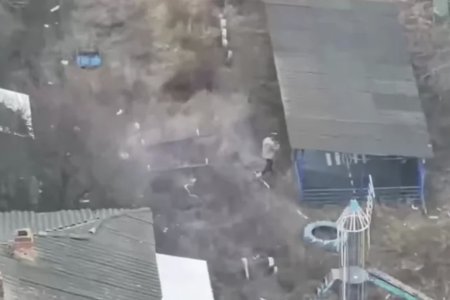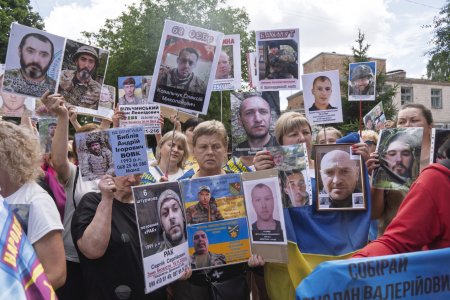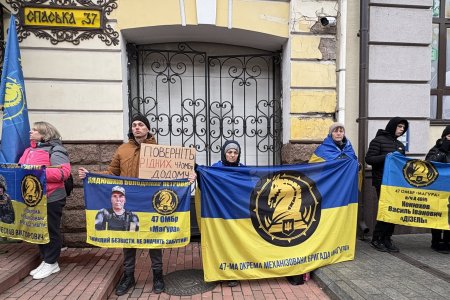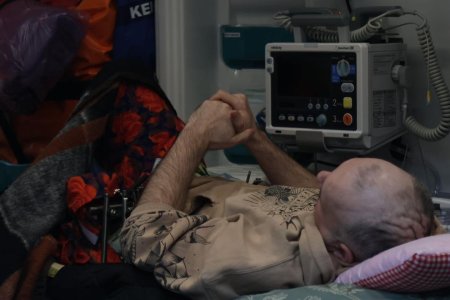
5340 victims of enforced disappearances
On July 30, the Media Center Ukraine hosted a presentation of a study by the global initiative T4P (Tribunal for Putin) on enforced disappearances. T4P was able to identify 5340 victims of enforced disappearances and sent a submission to the ICC and a summary to the UN Working Group.
The lawyers substantiated that Russia deliberately and systematically resorts to enforced disappearances. Representatives of the Russian Federation mainly persecute people who have a pro-Ukrainian position, and served in the Ukrainian army, police, or were civil servants. However, any person who finds themselves under Russian occupation can suffer from enforced disappearances.
Hanna Ovdiienko, a lawyer and co-author of the study, Mykola Komarovsky, a lawyer at the Kharkiv Human Rights Group, and Oleksandra Romantsova, executive director of the Center for Civil Liberties, explained what the crime is, what the relatives of the disappeared person should do, and how appeals to the International Criminal Court and the UN can help.
What is enforced disappearance and why should as many people as possible know about this crime?
As Oleksandra Romantsova explains, many disappearances in international law occur for various reasons. However, enforced disappearance is a special category, which implies that a person disappears because of the actions of other people who represent a certain state, or a certain political regime of the state.
In 2014, when Russia started a war against Ukraine, a wave of enforced disappearances began. In 2015, Ukraine acceded to the International Convention for the Protection of All Persons from Enforced Disappearance. According to the second article of the Convention, enforced disappearance is defined as arrest, detention, abduction, or any other deprivation of liberty committed by agents of the State or by persons or groups of persons acting with the authorization, support, or acquiescence of the State. At the same time, all of them refuse to recognize the fact of deprivation of liberty or conceal information about the fate or whereabouts of the disappeared person, which leaves this person without the protection of the law. The Rome Statute of the International Criminal Court defines systematic enforced disappearances as a crime against humanity.
Earlier, we emphasized that not all cases of disappearance can be considered enforced disappearances. A disappearance is seen as enforced if it is known to have been committed by the Russian occupation administration, the Russian military, militants, or persons who have defected to the enemy, and the person’s whereabouts have not been known since.

As Oleksandra noted, Ukrainians are “being held illegally, without any charges, in Russian prisons, or basements in the temporarily occupied territories or even in Belarus.” Russian armed aggression has led to enforced disappearances becoming extremely common in Ukraine.
Who is being persecuted and abducted by Russia?
“Russia has systematically committed enforced disappearances that are similar in scenario,” says Hanna Ovdiienko. The lawyer emphasizes that there is a certain pattern that is inherent in all enforced disappearances, regardless of where they occurred or which units of the Russian Armed Forces occupied the territory.
During the first wave of enforced disappearances, when Russian forces entered the territory of Ukraine, they had lists of people who then disappeared. “These were civic activists, civil servants, members of political parties, journalists, volunteers, public figures, human rights defenders, and other people who could have actively resisted the Russian propaganda machine,” Hanna mentions. Similar lists also include Ukrainians who could have provided active physical resistance: military personnel who refused to go over to the Russian side, border guards, and police officers.
The existence of the lists indicates that this was a prepared campaign by the Russian Federation, as the lists of Ukrainians were prepared in advance, meaning someone had collected them before.
During the second wave, any person pointed out by collaborators could become a victim of enforced disappearance, Hanna continues. People with specific professions became victims, even photographers could have suffered, she says. For example, if neighbors thought that a person was photographing Russian equipment, they could hand them over to the Russian invaders.
In addition, victims of enforced disappearances were people who expressed a pro-Ukrainian position, in particular, those who refused to switch to Russian and said that their native language was Ukrainian. Any statements in opposition to the actions of the Russian Federation could put a person in danger. However, the Russian occupiers could also kidnap random people who were pointed out by collaborators.
People could disappear for years. Very rarely did the Russian military say what happened to a person who, for example, was arrested at a checkpoint. In most cases, relatives’ requests went unanswered. The Russian military or the occupation authorities did not provide any information and did not say what happened to the person or where they were. In some cases, relatives still do not know what happened to the missing one. For example, even though the Kyiv region was liberated from Russian forces long ago, there are still many enforced disappearances there. These people are neither on the lists of prisoners nor on the lists of the killed…
What should relatives of the disappeared do?
As Mykola Komarovsky mentioned, the Kharkiv Human Rights Group has launched a hotline to help the relatives of missing civilians and soldiers. The hotline operates at 0800 20 24 02. This number is easy to remember because it encrypts the date of the beginning of the full-scale Russian invasion.
When you call this number, first KHRG operators collect basic information, then lawyers contact you and tell you the further algorithm of actions and start searching.
The lawyers of KHRG analyze the information from open sources, communicate with the released prisoners, check where the person applied at the national level, and submit the necessary appeals. Then the lawyers of the Kharkiv Human Rights Protection Group apply to the authorities of Russia or the so-called “authorities” of the temporarily occupied territories of Ukraine. When all the appeals have been submitted at the national level and the requests are directed to the enemy, KHRG applies to international bodies, including the UN Working Group.
Although KHRG cannot guarantee that every person will be found, in 30% of cases KHRG lawyers were able to find a person, added Mykola Komarovsky.

What data was collected for international institutions?
According to Hanna Ovdiienko, the report was recently submitted to the UN Working Group. A submission to the International Criminal Court was made even earlier: six months ago.
“We have collected the most confirmed cases to demonstrate the scenarios of the behavior of the Russian military and to provide as much evidence as possible,” Hanna says. “The documents do not just contain cases of people who disappeared, they also contain data on witnesses and evidence, sometimes even video from surveillance cameras.
In addition, the submission contains statistical data. As Hanna noted, the number of victims of enforced disappearances is constantly growing: if initially it was more than three thousand victims, now it is more than five thousand.
At the same time, the petition concerned only civilians who disappeared due to the actions of the Russian Federation emphasized Ms. Ovdiienko. There may be many more missing military personnel.
Where were the most enforced disappearances recorded?
As Hanna Ovdiienko explained, it is difficult to answer this question while many territories of Ukraine are under Russian occupation. Information from there will be available only after de-occupation.

Currently, human rights activists have recorded the largest number of victims of enforced disappearances in the Kharkiv region. This can be explained by the fact that almost the entire Kharkiv region has been liberated from Russian forces, as well as by the fact that lawyers of the Kharkiv Human Rights Group were able to travel to the de-occupied territories and collect information.
How do Ukrainian children suffer from enforced disappearances?
Mykola Komarovsky emphasized that it is important to distinguish between forced displacement and deportation and enforced disappearances. During forced displacement or deportation, Ukrainian children are illegally taken to the territory of Russia or the territories of Ukraine controlled by the Russian Armed Forces. There, they try to deprive children of their Ukrainian identity, teach them Russian curricula, force them to obtain Russian passports, and illegally place them for adoption. The ICC has now classified such actions by Russia as war crimes and issued an arrest warrant for Putin and his Ombudsperson for Children’s Rights, Ms. Lvova-Belova.
However, such actions by Russia can be considered both crimes against humanity and genocide. The Kharkiv Human Rights Group insisted on the latter in its submission to the ICC.
The submission “Forced transfer of children from Ukraine to Russia: Genocide” was aimed at persuading the ICC Prosecutor’s Office to reclassify the already opened proceedings from Article Eight of the Rome Statute (“war crimes”) to Article Six (“crime of genocide”).
When we are discussing enforced disappearances, we are talking about a crime against humanity. How can enforced disappearances happen to children? It is when Russian officials in the temporarily occupied territories of Ukraine detain a minor who seems suspicious to them, and no one knows where the child is and what status they have. If a child is left without minimal legal assistance, we are dealing with enforced disappearance.
Mykola Komarovsky said that in the submission to the ICC, 4% of enforced disappearances concerned children. Five children suffered from enforced disappearances in the Kherson region, 69 children in the Kharkiv region, and two children in the Zaporizhzhia region. In addition, the register of missing persons maintained by the Kharkiv Human Rights Group together with the hotline for missing persons currently includes 42 children. The T4P coalition’s database currently contains 99 episodes of enforced disappearances, but each episode has yet to be separately verified.
In turn, Oleksandra Romantsova emphasized that Ukrainian children have been suffering from enforced disappearances since 2014. In particular, children who drew graffiti in the temporarily occupied Donetsk became victims of enforced disappearances.

What to expect next?
Since human rights activists have already submitted all the collected information to the International Criminal Court, in the future the ICC Prosecutor may contact the victims directly, and Ukrainians will testify at the International Criminal Court, Hanna Ovdiienko said.
Oleksandra Romantsova also reminded that the ICC cooperates with the Ukrainian prosecutor’s office, so Ukrainian prosecutors can thoroughly formulate cases that will be taken into account by the International Criminal Court. In the future, there may be a separate criminal proceeding that will indicate who among the top leadership of the Russian Federation is responsible for the fact that Russian representatives committed enforced disappearances in Ukraine, whose orders led to enforced disappearances. It is worth remembering that the International Criminal Court is “hunting big fish,” Oleksandra emphasized, so Ukraine will be able to bring charges against a high-ranking official from Putin’s cohort later.
However, Ukraine must ratify the Rome Statute so that not only the perpetrators, not only those who kidnapped or tortured people, but also those who gave orders, commanded units, and were administrators of prisons or torture chambers where abducted people were held, can be brought to justice.
Moreover, each appeal to the UN will lead to the establishment of historical justice at the international level and support for Ukraine, Oleksandra emphasized.
She also mentioned that enforced disappearances have always accompanied Russian special operations: FSB, intelligence, and other security agencies of the terrorist country. “Enforced disappearances are a plague that has always accompanied the Russian army,” she expresses. “We have to remember that until Ukraine releases all its people, including those on the territory of the Russian Federation, [people] who are held in illegal detention centers or prisons, there will be no peace in Ukraine,” summarized Oleksandra. Moreover, the fight for justice allows us to overcome the Kremlin’s “fake storm”: to fight Russian propaganda, fake invasions and botnets, with which Russia is trying to distort the true picture of the world.
The presentation of the T4P study is available here.
The summary for the UN Working Group on Enforced Disappearances entitled “Enforced disappearances and displacement of Ukrainian children 2022-2023” can be found here. In turn, the online library of the Kharkiv Human Rights Group contains all previous submissions to the ICC and the English version of the submission on enforced disappearances.
The summary for the UN Working Group was prepared and published with the support of the International Renaissance Foundation. The material represents the position of the authors and does not necessarily reflect the position of the International Renaissance Foundation.



